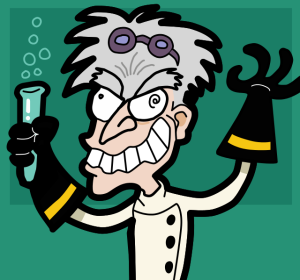
“Mad scientist“. Licensed under CC BY-SA 3.0 via Wikimedia Commons.
On August 14th and 15th, with sponsorship from FAPESP, the III BRISPE: Brazilian Meeting on Research Integrity¹, Science and Publication Ethics took place, with the aim of promoting ethical research integrity and responsible conduct by researchers in Brazil. In the two day event, 10 papers were presented on the problems of scientific misconduct, institutional policies and efforts that are being made globally to reduce a problem that has been growing in recent years. It had the participation of experts from prestigious foreign universities, from the American Association for the Advancement of Science (AAAS) and the Committee on Publication Ethics (COPE).
At the event, FAPESP presented the “Code of Good Scientific Practice²”, whose fundamental principle is to define that every researcher must exercise their profession in the most appropriate manner to result in the best contribution to the advancement of science. This manual provides the consensus that the scientific community and its institutions should self-regulate and establish their own codes of conduct, based on a three pillar strategy: (a) education; (b) prevention; (c) fair and thorough investigation and sanction. To achieve these objectives, the institutions should regularly promote educational activities on the values and skills relevant to ethical research integrity.
The manual of FAPESP defines (p. 15) that scientific activity is understood to be any activity directly aiming to conceive and conduct scientific research, communicate the results, the interaction among researchers and institutions, and mentoring or supervision in training processes. This definition applies to the exact, natural and human sciences and associated technological disciplines.
The scientific misconduct can take many forms. Among those highlighted at the event, the following can be mentioned: falsification of data, manipulation of results, plagiarism (text, ideas, results), ghostwriting, duplicated publications (salami), conflict of interest, manipulation of authors, etc.
As a basis for the Code of Good Scientific Practice there were taken as models the codes of conduct and procedure manuals adopted by international funding agencies, mentioning among others the National Science Foundation [2], the National Institutes of Health [3] of United States, the Research Councils UK code of conduct [4] in the UK, and the European Science Foundation code of conduct [5].
The FAPESP document does not deal with questions related to personal honesty or financial resource management or issues related to bioethics such as the preservation of biodiversity, preservation of the environment and public health. The main objective of the Code of Good Scientific Practice is to establish guidelines for scientific activities as detailed in Chapters 3 to 6.
The Chapter 3 of the manual of FAPESP analyzes in detail the application of the fundamental values and the different dimensions of scientific activity, giving attention to issues such as:
– Design, proposal and performance of research (originality and relevance);
– Presentation of research findings (plagiarism, authorship, salami);
– Recording, storage and accessibility of data and information;
– Peer review;
– Conflicts of interest;
– Mentoring.
Finally, issues of institutional responsibilities and formal procedures for investigating allegations of misconduct are treated in the two chapters that close the manual.
But the event went beyond the topics covered in the manual of FAPESP, as it delved into the issues that currently are motive for reflection at a worldwide level in the most advanced countries.
Some of the issues openly discussed between the panelists and the more than 80 participants were:
– What are universities of countries most advanced in research doing to teach ethical values to new scientists? What strategies were adopted for the courses? Are they mandatory? Presence or Web? What extent do they have? The most important question is whether these courses work, since the results are still being evaluated.
– Whether the formal education in ethical values will give the expected results in decreasing the scientific misconduct.
– What to do if one discovers that an important researcher or a university rector has been guilty of scientific misconduct, such as plagiarism? Will his doctorate be withdrawn? Can he further research? Can he receive awards? What is his future as a researcher?
– Will all countries accept the same ethical codes unanimously? This is an interesting case because, as Dr. Nick Steneck, University of Michigan, USA, told, when the Singapore Statement on Research Integrity³ was adopted, there was an item concerning whether scientists should decide on the importance of a topic for the advancement of science. The assembly was divided into two irreconcilable groups, one who felt that scientists must adopt decisions committed to society (concerned scientist) and the other who felt that no one can anticipate what importance can have a basic research conducted in the present with any future developments of new knowledge and technologies. Finally this point was not included as part of the statement since there was no consensus.
– Also it was discussed at the FAPESP event on the appropriateness of self-regulation of ethical codes by scientific societies, or whether there should be a basic framework established by government agencies that fund research and then adapted for each scientific community.
The III BRISPE: Brazilian Meeting on Research Integrity, Science and Publication Ethics, was also an opportunity for local research committees in Brazil to coordinate initiatives for the next world meeting on Research Integrity, which will take place next year in Rio de Janeiro – 4th WCRI (World Conference on Research Integrity).
Notes
¹ III BRISPE: Brazilian Meeting on Research Integrity, Science and Publicacion Ethics – http://www.fapesp.br/8788
² Code of Good Scientific Practice. Sao Paulo: FAPESP, 2014. 47p. – http://www.fapesp.br/boaspraticas/FAPESP-Code_of_Good_Scientific_Practice_2014.pdf
³ Singapore Statement on Research Integrity, 2010 – http://www.singaporestatement.org/index.html
Reference
Code of Good Scientific Practice. Sao Paulo: FAPESP, 2014. 47p. Available from: http://www.fapesp.br/boaspraticas/FAPESP-Code_of_Good_Scientific_Practice_2014.pdf
External links
National Science Foundation – http://www.nsf.gov/oig/resmisreg.pdf
National Institutes of Health – http://ori.hhs.gov/sites/default/files/42_cfr_parts_50_and_93_2005.pdf
Research Council, UK – http://www.rcuk.ac.uk/RCUK-prod/assets/documents/reviews/grc/goodresearchconductcode.pdf
European Science Foundation – http://www.esf.org/fileadmin/Public_documents/Publications/Code_Conduct_ResearchIntegrity.pdf
 About Ernesto Spinak
About Ernesto Spinak
Collaborator on the SciELO program, a Systems Engineer with a Bachelor’s degree in Library Science, and a Diploma of Advanced Studies from the Universitat Oberta de Catalunya (Barcelona, Spain) and a Master’s in “Sociedad de la Información” (Information Society) from the same university. Currently has a consulting company that provides services in information projects to 14 government institutions and universities in Uruguay.
Como citar este post [ISO 690/2010]:






![Comments on convenience authorship [Originally published as the editorial in Anais da Academia Brasileira de Ciências vol. 93 no. 3] Comments on convenience authorship [Originally published as the editorial in Anais da Academia Brasileira de Ciências vol. 93 no. 3]](https://blog.scielo.org/en/wp-content/uploads/sites/2/2021/08/charles-deluvio-AT5vuPoi8vc-unsplash_thumb.jpg)
![Preprints optimize research communication [Originally published as the editorial in Revista Habanera de Ciencias Médicas vol. 20 no. 4] Preprints optimize research communication [Originally published as the editorial in Revista Habanera de Ciencias Médicas vol. 20 no. 4]](https://blog.scielo.org/en/wp-content/uploads/sites/2/2021/08/national-cancer-institute-zoFbfT0M_BU-unsplash_thumb.jpg)
![Some remarks on peer review and preprints [Originally published as the editorial in Memórias do Instituto Oswaldo Cruz vol. 118] Montage. Photo of a data center, a corridor with machines occupying the wall and processing computer systems. In front, a vector illustration of a microscope and a cross behind. A braided circle around the two. At the top, the logo of the journal Memórias do Instituto Oswaldo Cruz. At the bottom, the text: Peer Review x Preprint.](https://blog.scielo.org/en/wp-content/uploads/sites/2/2023/07/mioc-thumb.png)







Recent Comments